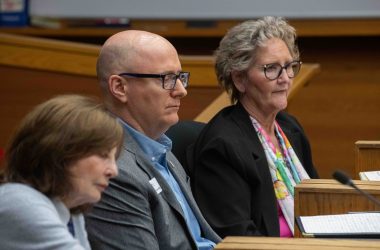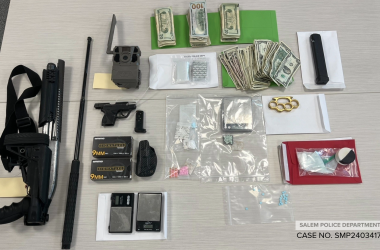
People look at panels detailing the Japanese experience in the Mid-Willamette Valley before and during World War II. (Courtesy/ Kylie Pine)
Kylie Pine remembers how one of the first requests she got as curator at the Willamette Heritage Center was centered on a common myth about Chinese immigrants. A person asked about underground tunnels in Salem where Chinese purportedly lived in the late 1800s.
There is no evidence that Chinese lived in underground tunnels. Now, the center is using a grant that will dispel myths about a population that was reviled and targeted by white settlers while also highlighting the rich history of the Mid-Willamette Valley’s rich Asian American community in the Salem community.
“The story that we want to tell is that there were people that lived here in spite of the harsh realities of the legal and social and economic issues that they were facing and survived and thrived,” Pine said.
A $5,500 grant from the Oregon Heritage Commission will help the heritage center buy hardware so that existing panels, which describe Japanese and Chinese stories locally, can be checked out by different community organizations.
“This is allowing us to take those panels and give them a little bit more life and also tell the stories outside of our museum walls and hopefully working with other partner organizations,” Pine said.
She cited the World Beat Festival as an example.
One of the panels explores Japanese American history before World War II, when many families farmed celery in the Labish Village area, just north of Keizer.
Pine said the museum did an exhibit four years ago that explored the Japanese American experience during World War II when they were forced into internment camps.
“Which was particularly traumatic as most of the individuals of Japanese heritage were forcibly removed from their homes and placed in incarceration camps,” she said.
Those in Marion County were initially sent to camps in Northern California, she said. Some were later moved to Heart Mountain in Wyoming, where more than 14,000 people were incarcerated.
“The experiences weren’t monolithic. Some people were released to go back to school… some people went to work on beet farms out in eastern Oregon,” Pine said.
 A panel describing Japanese history in the Mid-Willamette Valley. (Saphara Harrell/Salem Reporter)
A panel describing Japanese history in the Mid-Willamette Valley. (Saphara Harrell/Salem Reporter)
The grant will get hardware to make the panels, which Pine said are flimsy on their own, more portable.
She hopes it will be the foundation to a larger exhibit that explores more details of the Asian American experience locally with artifacts.
While Salem is an overwhelmingly white community, she hopes the project will help realize that there are communities of color that have also called the area home.
“Historically there’s always been individuals of color, communities of color that have been here since a really long time. And so how do we bring those stories to the forefront that don’t necessarily show up in some of the other historical museums and documents?” she said.
She said bringing those stories to light can be difficult, because preserving the history of those who were heavily discriminated against may not have been a priority for record keeping.
“And it’s hard, it’s a challenge for us,” Pine said. “We can talk about systemic racism within the museum as well. In the way that the structures have been set up, those stories haven’t always been saved, cared for, classified, sought out, and looked for.”
There were racist ordinances in Salem’s city code that only applied to noodle houses owned by Japanese and Chinese proprietors that required them to keep the windows open, Pine said.
“Some of the challenges for us as historians is ‘Why was that?’” she said.
In recent years, historians in Salem have increase efforts to bring to light the experiences of Chinese immigrants in Salem.
Kimberli Fitzgerald, the city’s historic preservation officer, traveled to China in 2018 to find family members of those who lived in Salem’s Chinatown. A utility box in downtown Salem at the corner of State Street and High Street Northeast details some of Chinatown’s local history.
Fitzgerald’s work included unearthing a shrine at Salem’s Pioneer Cemetery, used during the Qing Ming festival in the late 1800s, which is the Chinese traditional day for honoring the dead and cleaning headstones.
In April, people gathered there to celebrate the third annual Qing Ming Festival.
Contact reporter Saphara Harrell at 503-549-6250, [email protected].
JUST THE FACTS, FOR SALEM – We report on your community with care and depth, fairness and accuracy. Get local news that matters to you. Subscribe to Salem Reporter starting at $5 a month. Click I want to subscribe!









